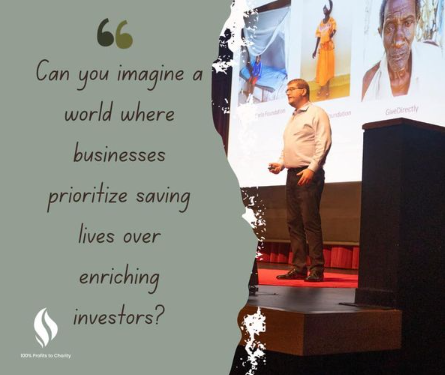Many people consider Bill and Melinda Gates to be the prototypical rich philanthropists. Forbes ranks Bill Gates as the world’s second richest person, with $90 billion, falling short of Jeff Bezos, who has a net worth of $112 billion.[1] But the only reason Gates missed the top spot is because he used much of his earnings to occupy the apex of a different Forbes list: The Billion Dollar Givers. Gates has already given away $50 billion and has pledged to give away more.[2]
The Gates’ philanthropy is well-known to many. We’ve all seen images and video footage of them in extremely poor villages, talking to the people they are trying to help. While the Gates may embody the ideal of ultra rich philanthropists dedicating themselves to those less fortunate, this is by no means the standard among the rich—even among rich philanthropists. Many treat philanthropy like a personal hobby, writing checks for things they like that may provide some societal benefit, rather than trying to do the most to help others.
We can see this by looking at the mega-donations from 2011-2013 (more recent years exhibit similar trends).[3] 12 percent of the gifts over a million dollars were focused on cultural areas such as the arts, museums, or sports. As an example, billionaire David Koch made several of these gifts.[4] One was a $35 million donation to the National Museum of Natural History for a new dinosaur exhibit hall. Koch told the Washington Post that one of the reasons he made this donation is because dinosaurs have always fascinated him. “It goes way back,” Koch said. “I went to my first dinosaur hall with my father and twin brother. We went to the American Museum of Natural History, and I was blown away by the dinosaurs.”[5] Koch also gave $65 million to the New York Metropolitan Museum of Art, financing a renovation of the outdoor plaza around the museum. The New York City Opera received a $1 million gift from him too. This was just a drop in the bucket for the opera, though, as Koch previously pledged $100 million to renovate its performance center.[6]
The style of Koch’s giving is quite different from that of the Gates Foundation. Koch likes dinosaurs, art, and opera, and directed his giving accordingly. Certainly people from many walks of life can, in theory, appreciate the improvements from Koch’s gifts, but it’s unlikely that this is how things play out in reality. As observed in a Big Think article, “the audience for most American museums is blindingly white in composition. Citing another study, Davis writes, “Among those who frequented art museums, a stunning 92 percent identified as white, and only 16 percent identified as a minority.”[7] It is a far stretch to suggest that these gifts were designed to maximize the good they could accomplish.
Gifts to cultural institutions are not the only questionable mega donations. 62 percent of the donations over $1 million were to colleges and universities. There is certainly a stronger case for this type of giving, as higher education provides many important benefits to people from a variety of socioeconomic backgrounds. However, many of the mega gifts from the rich are designed to create or bolster elite institutions for the elite, rather than to improve opportunity for the general public.[8] The rich often treat philanthropy as a personal showcase, financing new buildings (named after them) and endowing professorships (in the subject areas that interest them). Many also give as “grateful recipients,” thanking the universities that contributed to their own lives, rather than seeking the schools that could make the best use of a donation. While these donations are better than nothing, this type of philanthropy is very different from giving with the purpose of improving the world. Harvard’s endowment is about $36 billion, Yale has $27 billion, and Stanford’s is $25 billion.[9] Meanwhile, college education is getting less affordable for the middle class and our K-12 education system is in decline.
Another 12 percent of mega donations were to health-related charities and hospitals. The role that donors play in health care is complex and personal. Most gifts go to hospitals and illness-related causes that have touched the lives of donors. Certainly some of these donations are examples of great philanthropy. But the donors tend to be members of the middle and upper class in wealthy countries, which means that a disproportionate percent of donations are directed to researching and administering advanced treatment for illnesses that address their demographic, while much less is dedicated to diseases of poverty like malaria, diarrhoeal diseases and tuberculosis, which cause suffering and death for millions globally.[10]
One of the reasons health care costs are increasing is because new technologies are searching for solutions that are more effective, not more affordable. While some people are getting better care from new technology, others are no longer able to afford care at all. Why don’t we search for lower-cost prevention and treatments for illnesses to touch those without insurance? Probably because those people can’t afford to donate, or lobby.
There is a thin tightrope to walk with critiquing donors—should they be compared to people who donated more effectively or people who didn’t donate at all? A common view is that we should be grateful that donors are doing something to improve society, even if it’s not always what would be most beneficial. This is a valid argument. However, it is important to realize that not all wealthy philanthropists are magnanimous saints, as many are not particularly intent on doing what will bring the most benefit to the world. If such philanthropists were to rethink where to direct their gifts, we would have a better chance of moving the needle on deep problems like extreme poverty.
The way to address the patterns of mediocre giving —for the rich as well as middle-class donors, who exhibit similar behavior[11]—is to change the paradigm for approaching charitable giving. Donors should focus their giving less on causes that reflect their personal interests and more on areas that will help others most, and society should not give equal praise to all donors. Those who want to treat giving more as a hobby rather than a means for dramatically helping others can of course continue doing so, but they should be under no illusions that their giving is reaching its true potential.
[1] http://www.forbes.com/billionaires/
[2] Gilchrist, Karen. CNBC. “Bill Gates makes $4.6 billion pledge, his largest since 2000.”
https://www.cnbc.com/2017/08/15/bill-gates-donates-4-6-billion-largest-pledge-since-2000.html
[3] “Chronicle of Philanthropy list of gifts over $1 million: http://philanthropy.com/factfile/gifts
[4] “No. 11: David Koch.” Chronicle of Philanthropy. 10 February 2013. http://philanthropy.com/article/No-11-David-Koch/137119/
[5] Trescott, Jacqueline. “David Koch donates $35 million to National Museum of Natural History for dinosaur hall.” Washington Post. 3 May 2012. http://articles.washingtonpost.com/2012-05-03/lifestyle/35455230_1_dinosaur-hall-natural-history-museum-dinosaur-exhibit
[6] http://pressroom.nycopera.com/pr/nycopera/news/TheaterRenamed.aspx
[7] https://bigthink.com/Picture-This/does-the-art-world-have-a-demographics-problem
[8] https://www.forbes.com/sites/bridgespan/2016/04/27/why-big-donors-are-under-fire-for-big-gifts/#20fd7b002ef5
[9] “The 100 Richest Universities in North America.” https://thebestschools.org/features/richest-universities-endowments-generosity-research/
[10] https://www.philanthropy.com/factfile/gifts
[11] https://static1.squarespace.com/static/55723b6be4b05ed81f077108/t/55d24c66e4b05537993238fc/1439845478132/%24FG+II_2011_Full+Report.pdf



